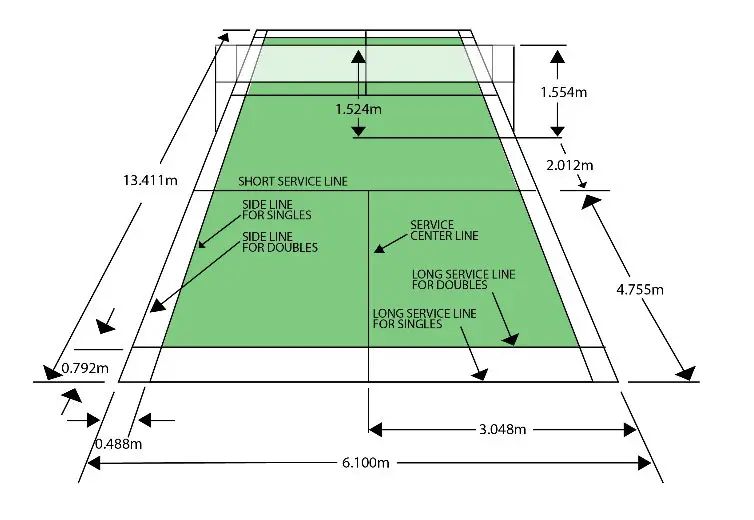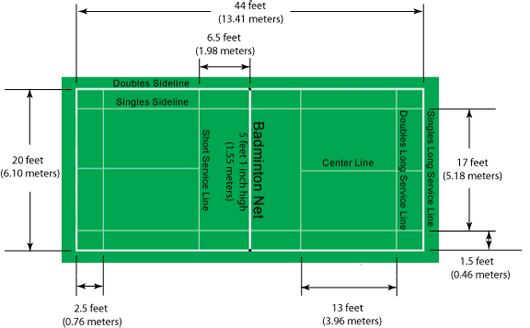If you want to play badminton, you can actually play at any place you want. You can set up a badminton court in your backyard, assuming you have enough space and a pretty flat yard. If you don’t, you should be able to find a flat area in a nearby park to set up the badminton court for an afternoon of family fun.
But if you want to play more serious badminton, you will need to play on a badminton court. Even though you can play badminton outdoor, but because of the wind factor, the shuttlecock tends not to follow the direction where it should head, so it is best for you to play indoors.
Badminton Court Dimensions in Meters

The official size and dimensions of a standard badminton court have featured a length of 13.40 meters. For doubles, the width is 6.10 meters whilst for singles, the width is 5.18 meters.
The diagonal length is 14.723 meters for doubles, while for singles, the diagonal length = 14.366 meters.
The measurement of the width of the white line is 4.0cm.
The center of the site is divided by the net (the height of the post on both sides is 1.55 meters in height from the surface of the court. The height of the top of the net is 1.524 meters.)
You can refer to the below diagram for the design and layout of a standard badminton court that follows the rules and requirements of the Badminton World Federation (BWF). The drawing will outline the floor plan of the court and the measurement in meters for each part with labels.
However, if you’re playing just for fun and don’t have quite that much room, you can shrink these dimensions somewhat. Just remember that if you shrink the length, you need to shrink the width, too. For example, if you need to lop 10’ off the length of your court, you should also shrink the width by one-fourth.
Material Used for Construction
The ideal badminton court is made up of elastic wood flooring material. (as long as the small wooden blocks are not spliced vertically). At present, the court for international competition has adopted bituminous(chemical synthetic materials) to build a movable plastic court.

While for non-international competitions, if they don’t have the chemical synthetic court, you can also compete on the court of (concrete)cement, triad, or carpet. It is not recommended as playing on the surface will easily get you injured.
Today, you can find badminton courts in most schools, universities, gymnasiums, institutions, hospitals, etc. Most of the courts are either using wood flooring or synthetic flooring. This ensures athletes do not get too slippery or sticky while playing the game and have a certain degree of flexibility.
Badminton Court Construction Detail
Before creating your badminton court, be sure to clear away all obstructions and make the floor flat.
You will start with a tape measure and measure off the court’s length and width.
The idea is to create a perfect rectangle that you may not do on the first try. So, the good idea is to mark each line with at least two dots of white floor paint. This way, you can make some adjustments later if needed.
Next, form the court using white or yellow string and white dots. If it looks like you’ve made a good rectangle, you can then create the finished lines with white or yellow spray paint. If the rectangle looks lopsided either way, be sure to make the necessary corrections before you spray the lines.
Placing The Posts And Net
Once you have your badminton court laid out, you will need to measure in half from one of the back lines to place your posts and the net. For example, if you’re making a full-size court, you need to measure off 22’ from one of the back lines.
The next thing you need to do is divide each side of the two halves of the court into two to form the right and left service courts. In other words, make a line halfway between the court’s sidelines–or 10’ for a full-size court. You should now have four rectangles, each measuring 22’ by 10’.
Creating A Badminton Service Line
Next, measure out 6’ 6’ from the centerline (where the net will be) and make a line. This will be your service line. You will need to do this on both sides of the centerline as there needs to be a service line on both sides of the net.
If you are playing doubles, you will also need to create a line 3’ inside both your sidelines (the width lines).
Finally, install the badminton net. Most nets are just placed in the ground with string-tied stakes. However, you can also get a more “professional” net that has tension devices to help keep the net from sagging over time.
Preferred Surfaces For A Badminton Court
If you are a more serious badminton player, you’ll be playing badminton indoors. If you play at a recreation center with badminton tournaments or a badminton “ladder,” you can’t be much of a chooser.
You’ll probably be playing on some form of wooden plank flooring–one that’s used for basketball, badminton, and who knows what else. If you’re lucky, the facility will lay out rubber floor mats on the wooden flooring for badminton, as this is easier on the back and legs than just the wood.
If you’re lucky and live near a badminton club, you might play on a surface created specifically for badminton, such as Play-Turf® or a vinyl-PVC sports flooring.
You may not have much of a choice in badminton flooring, but if you do, the preferred choice would be either the Play-Turf or the vinyl-PVC sports flooring. Both provide a good surface for turning, running, and stopping; and are easier on your body than wooden-plank flooring.
Construction Cost
If you wonder how much it is to construct an indoor badminton court, many factors need to be considered.
My friend is a constructor, and he ever built a building for his client that consists of 15 badminton courts. The total construction cost, including complete infrastructure, is $1 million. The price is not cheap.
If you already have room to accommodate a badminton court, you can try to get a court mat with lines readily painted, which may just cost you around $3,500. If you get a branded one like from Yonex, then the cost will be about $10,000.
Badminton Court Lighting Standards
-
- Amateur competition (training): 150lx-300lx
- General competition: 300lx-500lx
- Official competition: 500-750 or higher (can be up to 1500lx).
- The auditorium is 30lx-100lx.
(The lux (symbol: lx) is the SI-derived unit of illuminance and luminous emittance. The measurement is equal to one lumen per square meter.)
Standard Lighting Layout:
- Use the lamps on the ceiling for general illumination and then add auxiliary light-transmitting illumination from higher positions on both sides of the net.
- Side lighting or indirect lighting using indoor sidewalls.
- The lamp should have a light barrier to prevent glare.
- The white shuttlecock and the background have good contrast, the interior wall and ceiling are preferably brown or green, and the floor is decorated with low reflectivity.
Other Flexible Lighting Setting
- The light source is illuminated by a metal halide light (Osram or Philips).
- You should illuminate the lamps, the reflectors should be clear, and the integrated lamps should be used.
- The power of the light source is 400w-1000w (or even 2000w [expensive]) according to the height and the density of the light.
- The lights can be grouped and controlled according to different game levels.
Badminton Court vs. Tennis Court Size
The tennis court is rectangular with 23.77 meters (78 feet) and 8.23 meters (27 feet).
The net divided the whole field into two halves. The net is made of braided net cord material with a diameter of no more than 0.8 cm (1/3 inch).
The ends of the net are suspended on the post with less than 15 cm in diameter (6 inches).
The height of the net post shall not exceed 2.5 cm (1 inch) at the top of the rope. The center of the post is 0.914 meters (3 feet) from the outer edge of the line.
Badminton Court vs. Pickleball Court
The size of the pickleball court is similar to the badminton court. There are only 2 differences between them.
The first one is the net. Pickleball court has a lower net compare to the badminton court.
The second one is:
Pickleball: no volley zone is 7 feet from the net
Badminton: no service line is 6.5 feet from the net

How much would it cost to build 2 to 4or 5 badminton courts
The cost of building 2 to 4 badminton courts varies depending on a number of factors, including the size of the courts, the materials used, and the labor costs in your area. However, as a general estimate, you can expect to pay between $20,000 and $40,000 to build 2 to 4 badminton courts.
Here is a breakdown of some of the costs involved in building badminton courts:
Land: The cost of land will vary depending on the location and size of the property.
Site preparation: This includes clearing the land, leveling the ground, and installing drainage.
Foundation: The foundation is important for supporting the weight of the courts and preventing them from sinking.
Court surface: There are a variety of court surfaces available, including concrete, asphalt, and synthetic turf. The cost of the court surface will depend on the material chosen and the size of the courts.
Lighting: If you plan on using the courts at night, you will need to install lighting.
Fencing: Fencing can help to keep the courts secure and prevent people from entering the area without permission.
In addition to these costs, you may also need to factor in the cost of permits, inspections, and other fees.